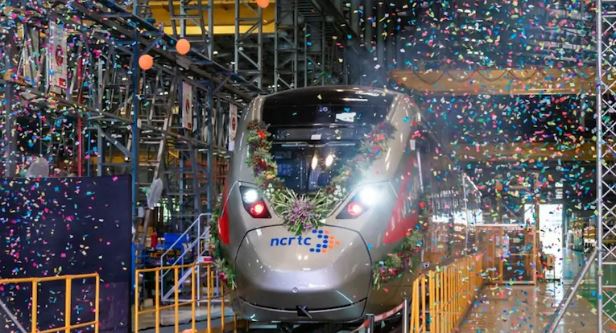
Real estate experts say that rates of properties in these areas have increased by 35-40 percent in the last two years.
Avnish Chaudhary, who works at a multinational company in Delhi and lives in Noida, has put off his plan to buy a house in Noida or Ghaziabad. Instead he has decided to live with his family in Meerut and commute to the national capital via the upcoming Regional Rapid Transit System (RRTS), a rail-based semi-high-speed link between Delhi and Meerut that is expected to be fully operational by 2025.
“I currently live in Noida and everyday drive to my office in Delhi which takes over an hour. I was planning to buy a house here but since the RRTS is likely to become operational in two years, I plan to shift permanently to Meerut. I will buy a bigger property in Meerut and live with my family there. Once the RRTS is up, it will take almost the same amount of time that it takes me currently to reach my office in Delhi’s Nehru Place via car,” Chaudhary, a native of Ghasuli village in Meerut, told Moneycontrol.
Chaudhary added that Delhi’s satellite towns such as Noida, Ghaziabad and Gurugram have already grown a lot and are crowded while the improved connectivity to Meerut from the national capital will give people from that region an option to live and invest in property there without compromising their career prospects.
There are several others like Chaudhary who are currently living on rent in Delhi, Noida or Ghaziabad but plan to move back to their native places in Meerut, Modi Nagar or Muradnagar that fall within the RRTS network, driven by the improved connectivity and cheaper real estate opportunities there.
With the introduction of the RRTS between Delhi and Meerut via Ghaziabad and the commissioning of Delhi Meerut Expressway, properties located along the corridor in Meerut, Modi Nagar, Muradnagar, Duhai and several localities in Ghaziabad are witnessing a boom.
Real estate experts say that rates of properties in these areas have increased by 35 to 40 percent in the last two years.
The National Capital Region Transport Corporation (NCRTC) is implementing India’s first 82-km Delhi-Ghaziabad-Meerut RRTS corridor, which is a semi-high-speed rail-based transit network. This corridor will have 25 stations including two depot stations.
The RRTS corridor will start from Sarai Kale Khan in Delhi and pass through areas such as Anand Vihar, and Uttar Pradesh’s Sahibabad, Ghaziabad, Duhai, Muradnagar, Modi Nagar and Meerut to culminate at Modipuram.
The 17km priority section between Sahibabad and Duhai is likely to open by March this year while the entire corridor will be commissioned by 2025.
The RRTS will cover the 82 km between Delhi and Meerut in 55 minutes.
In Meerut, metro services will be provided on the RRTS network with 13 stations in 21 km for local transit needs. Partapur, Shatabdi Nagar, Baishali, Brahmpuri, Modipuram and Meerut North will be some of the key metro stations in the city.
According to NCRTC officials, the metro trains will run on the same tracks as RRTS. The only difference will be that the RRTS trains will stop only at RRTS stations while metro trains will stop at all 13 stations.
All this has a direct bearing on the real estate market.
Vinay Kumar Singh, Managing Director, NCRTC, said, “A project of this magnitude always impacts the real estate of the nearby region in a positive manner. The RRTS corridor will not only facilitate high-speed, safe and comfortable travel but also open up new investment opportunities in its influence zones. This will lead to densification around the transit stations and corridors and eventually turn into developments of new areas, increasing the value of properties.”
Real estate opportunities along the corridor
Real estate experts say that the RRTS corridor and the Uttar Pradesh government’s recent Transit Oriented Development policy, which seeks to develop areas along the corridor, are game changers.
Mahendra Kasana, a real estate broker active in Meerut and Modi Nagar, said that areas like Modinagar, Muradnagar and Meerut lost out to residential hotspots like Gurugram or Noida because of lack of good connectivity but that will no longer be the case.
“Now people who tend to buy properties in Delhi, Noida, Ghaziabad and Gurugram are opening up to investing in areas like Meerut, Modi Nagar, Muradnagar, Duhai and the outskirts of Ghaziabad. The Delhi-Meerut Expressway has already improved connectivity in the region and the RRTS will further boost it so all these factors have opened up more real estate opportunities in this region,” Kasana told Moneycontrol.
He said that land rates have gone up by 35 to 40 percent in the last two years in areas along the RRTS corridor, having risen from Rs 12,000-15,000 per square yard a couple of years ago to between Rs 18,000 and Rs 20,000 per square yards.
Another real estate executive in the area, Tajender Nagar said that real estate development anywhere hinges on two things: good connectivity and security.
He said that the Delhi-Meerut Expressway not only improved connectivity with Delhi and other NCR towns but also decongested NH-58 (old Delhi-Meerut route).
Ashok Garg, president, Real Estate Developers Association of Meerut (REDAM), claimed that prices have shot up for properties located along the RRTS route especially in Meerut and stressed that the growth in the city was encouraging.
“Land rates have generally gone up by 35 to 40 percent in areas located around RRTS route and the growth is even higher, up to 50 percent, in Meerut city areas located around RRTS stations such as Shatabdi Nagar, Brahmapuri, and Partapur among others,” he said.
Garg added that rates of properties in these areas are now between Rs 22,000 and 25,000 per square yard versus Rs 16,000 to Rs 18,000 per square yard a few years back.
He added that unlike Noida and Gurugram, people in this region prefer plotted developments rather than high-rises because they believe in ownership of the land.
But this is slowly changing, and a number of small and big developers in Meerut including Indus Valley, Sikka Group, A2Z Builders & Developers and Alpha Corp have projects underway in and around Meerut, Garg said.
“People generally live in big or joint families here hence they need bigger houses which is not very easily available in apartment culture so they tend to buy land and make houses. But slowly this culture is changing and people are also investing in apartments here,” Garg explained.
Ansh Batra, director, Buniyad Group, said that faster appreciation in prices of plots, primarily in locations like Modi Nagar, Murad Nagar and outer pockets of Ghaziabad, is certain as the 17-km priority section of the RRTS is set to be operational by March 2023.
How will TOD policy help?
The Uttar Pradesh government in September approved the TOD policy along the RRTS corridor.
A senior official at the Ghaziabad Development Authority (GDA), who asked not to be identified, said that along the RRTS corridor at Duhai, Guldhar, Muradnagar and Modi Nagar, the land use is primarily agricultural but with the recently approved TOD policy, this land use will now be altered to residential, commercial, retail and mixed use.
He added that in the trans-Hindon areas of Ghaziabad, which already have high-rise apartments, the policy will carve out a ‘TOD influence zone’ which will encourage vertical development.
The base FAR, which is the total built-up area allowed on a particular plot, will be increased in areas that fall under the TOD zone, he said.
Santosh Agarwal, CFO and Executive Director, Alpha Corp, said, “The approval of the Transit Oriented Development policy that applies to areas in 1.5 km radius of the upcoming Delhi-Ghaziabad-Meerut RRTS Corridor will be a game changer for the realty landscape of Meerut, Ghaziabad and nearby areas. RRTS being the modern public transport mode in the region will also add to the high appreciation of prices in the real estate sector of Meerut and surrounding areas.”RRTS affordability
There are some who fear that the connectivity provided by the RRTS will come at a cost.
Shyam Sunder Bassi, a native of Muradnagar who commutes every day to Ghaziabad, said, “RRTS is no doubt a good initiative but it will very likely be an expensive mode of commute between Delhi and Meerut. If tickets of the RRTS are priced high, it will not be affordable for a good chunk of the population. This will not only compromise the very cause of such a big transport mode but also likely to have its impact on the real estate growth in the region.”
NCRTC authorities have indicated that fares will be a tad on the higher side.
“Prices of tickets on the route are yet to be decided. It is likely to be kept higher than that of the metro. The RRTS trains will also have premium class which will be even higher than that of the normal fare,” an NRCTC official said.





















